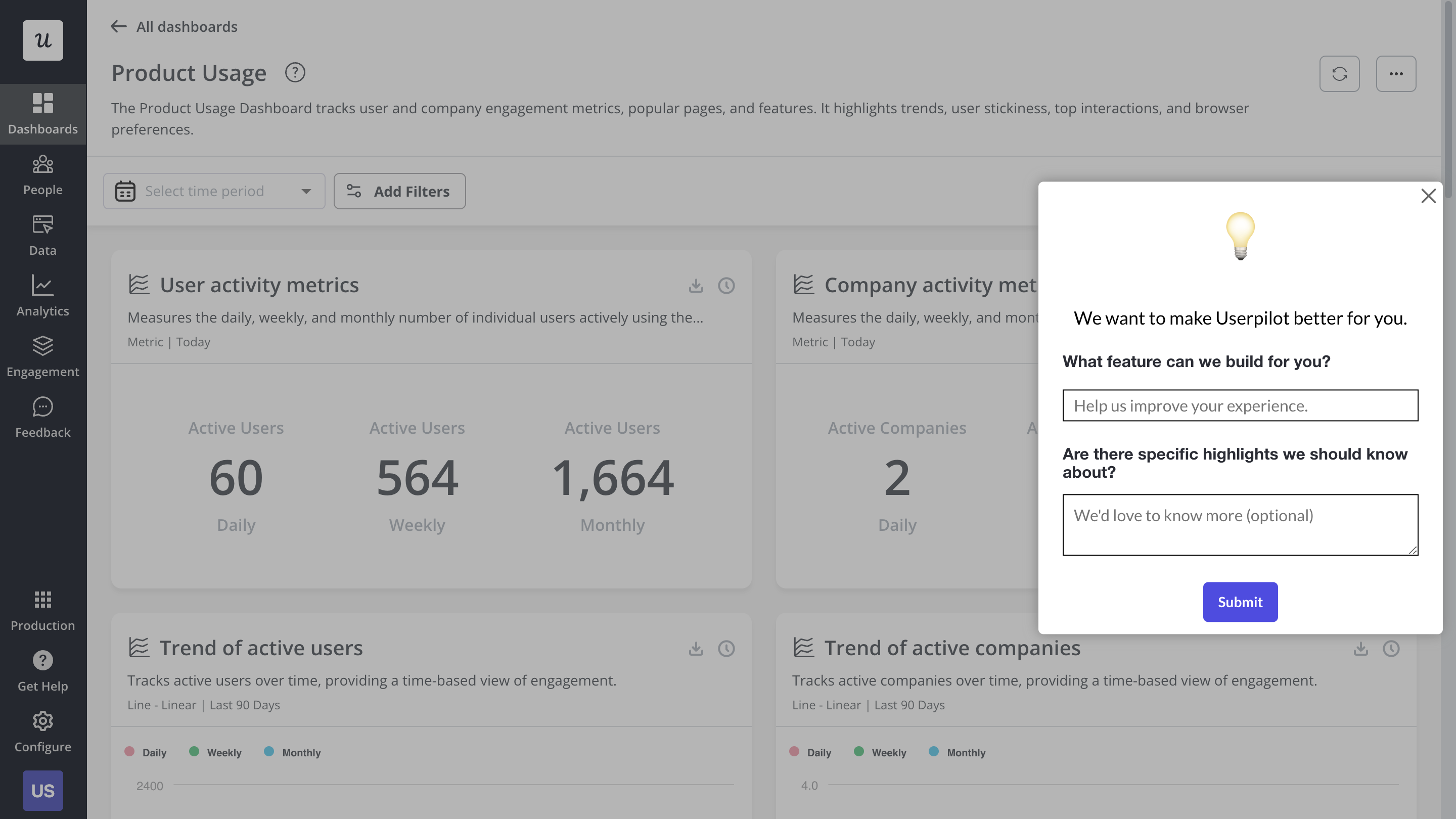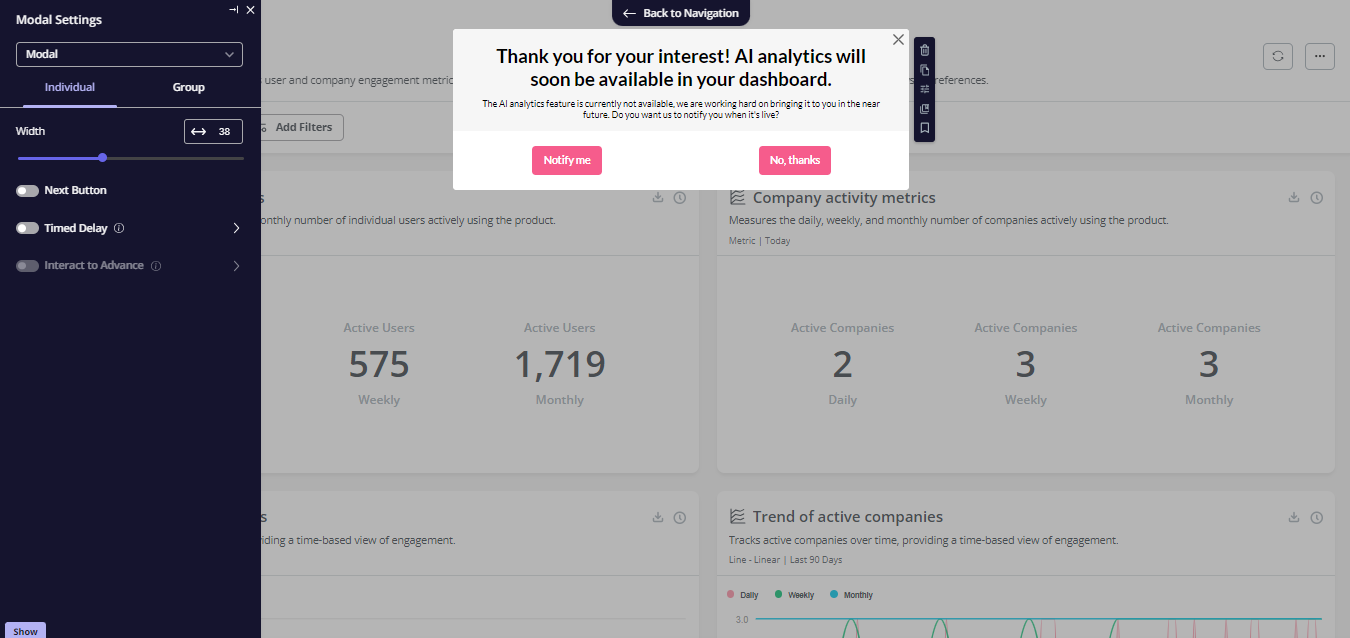
Try Userpilot Now
See Why 1,000+ Teams Choose Userpilot

What is the weighted scoring model?
A weighted scoring model is a decision-making technique that helps product and project managers prioritize options by assigning different levels of importance (weights) to specific criteria and then scoring them. For instance, when using data from in-app feedback.
Each option is evaluated based on how well it meets each criterion, and the scores are multiplied by the assigned weights. The total score for each option is then calculated by summing the weighted scores, making it easier to identify the best choice.
For example, you can do a cost-benefit analysis by assigning weights to the costs and benefits of each option.
What is the difference between the unweighted and weighted scoring framework?
In both weighted and unweighted scoring models, teams assign values according to each of the criteria.
However, in the unweighted frameworks, each of the criteria is worth the same. In the weighted scoring model, some of the categories are more important than others – they get more weight.
For example, in the weighted model, the benefit and cost categories may have a 66/33 ratio, while in an unweighted model, these two would be equally important, so the ratio would be 1/1.
When to use the weighted scoring method in product and project management
Product and project managers use the weighted scoring model for:
- Evaluating ideas
- Prioritizing features
- Selecting a tool
- Assessing risks
- Allocating resources
- Prioritizing outstanding tasks or backlog items
Overall, the weighted scoring model is preferred for complex and high-stakes decisions.
Benefits of the weighted scoring matrix
There are a number of pros of using a weighted scoring framework, such as:
- Prioritization of criteria – the weighted factor analysis allows teams to assign different importance levels to various criteria, providing a more nuanced evaluation.
- Comparison of alternatives – the weighted score calculation provides a clear framework for comparing multiple options against the same set of criteria, which makes it easier to see which option scores higher overall and make informed decisions.
- Transparency – weighted decision-making fosters transparency by allowing stakeholders to see how decisions are made, which criteria were considered, and how each option was evaluated.
- Flexibility – you can adapt the weighted scoring models to various contexts, making them applicable for different types of decisions, such as selecting vendors, evaluations project proposals, or choosing tools.
- Cross-functional alignment – by involving the key stakeholders and members of other teams to select the criteria and weights, you build a shared understanding of your product goals and priorities.
Drawbacks of the weighted scoring matrix
Despite its strengths, weighted scoring does come with a few downsides:
- Subjective scoring – even if the criteria are clear, it’s not easy to assign specific values to score features or tasks objectively.
- Weighted scale – the matrix may oversimplify complex decisions by reducing them to numerical scores. This reduction can overlook qualitative factors, nuances, or interdependencies between criteria that are not easily quantified.
How to create a weighted scoring model in 6 steps
Let’s imagine that you’re building a mobile health and wellness app and currently working on a major product update. As a product manager, you need to prioritize the features to include in the update, so you decide to use the weighted scoring model.
Here’s how you can apply the framework, step by step.
1. Identify and list down all possible options
The first step is identifying all the possible features you may want to include in the update.
This normally includes customer research to discover their needs, wants, and pain points.
Once you do this, it’s time to work out how you address the problems. In this hypothetical scenario, your team has come up with 5 possible features, some of which have been requested by your current users:
- Enhanced exercise tracker
- Nutrition planner
- Meditation guide
- Sleep tracker
- Community feature for user interaction
2. Define criteria relevant to your decision
Once you have identified the features, it’s time to select prioritization criteria.
You can do it in two ways. One option is to use a ready prioritization framework like RICE, ICE, or Value vs. Effort. If you choose RICE, your criteria will be Reach, Impact, Confidence, and Effort. If ICE, it would be Impact, Confidence, and Ease, and so on.
Alternatively, you can choose bespoke criteria reflecting your goals or values.
If we take the latter approach, your criteria can be:
- User demand
- Market competitiveness
- Potential for revenue generation
- The development cost
- Implementation complexity
3. Assign a numeric weighting value to each criterion
Having identified the scoring criteria, you now need to assign each of them a numerical value.
There are two things to remember here:
First, group the criteria in terms of their impact, either positive or negative.
Out of the 5 criteria you’ve identified, user demand, market competitiveness, and potential for revenue generation are all positive, and the development cost and implementation complexity are negative.
Second, the weighted values you allocate to features in each group should make up the total of 100%.
This is our allocation:
- User demand (50%)
- Market competitiveness (20%)
- Potential for revenue generation (30%)
On the other side, you have:
- Development cost (70%)
- Implementation complexity (30%)
4. Score each option and calculate their weighted score
After assigning the weights to each of the criteria, you’re ready to score them. How is weighted scoring calculated?
Start by selecting a scale, for example, 1-5 or 1-10. In our case, we’ll use 1-5.
Next, score each feature according to each criterion.
For example, these are the scores for the enhanced activity tracker feature:
- User demand – 3
- Market competitiveness – 5
- Potential for revenue generation – 3
- The development cost – 5
- Implementation complexity – 4
Next, calculate the weighted scores by multiplying the assigned weights and scores.
- User demand (3 x 50% = 1.5)
- Market competitiveness (5 x 20% = 1)
- Potential for revenue generation (3 x 30% = 0.9)
- Development cost (5 x 70% = 3.5)
- Implementation complexity (30% x 4= 1.2)
Pro tip: To make the scoring easier, use a spreadsheet to create a weighted scoring chart.
In the rows, list all the features, while in the columns – the criteria. Under each of the criteria, write the weighting value for easy reference and to automate the calculations later on.

5. Sum up the total score for each option
To calculate the overall score for each feature, add the weighted scores for all the positive features and divide them by the sum of the weighted scores for all the negative ones.
So in the case of the enhanced exercise tracker, this is (1.5+1+0.9)/(3.5+1.2)=0.72
6. Compare the scores and make a decision
We’re nearly there. All you have to do now is compare the scores and use the data to make a decision on what goes into the update.
Here they are:
- Enhanced exercise tracker – 0.72
- Nutrition planner – 1.04
- Meditation guide – 0.5
- Sleep tracker – 1.69
- Community feature – 3.36

You can see that the community feature and sleep tracker have the highest scores, so that’s what you decide to develop.
Next steps: What should product teams do after analyzing weighted scores?
Nearly there! All the features are prioritized so you only have a couple more things to do.
Carry out concept testing to validate ideas
Before starting to build the features, make sure to validate them through concept testing.
This basically means double-checking if users actually want the feature and are willing to pay for it. In this way, you avoid investing resources into functionality that nobody uses.
Useful validation techniques include:
- User interviews and focus groups – with Userpilot, you can launch in-app modals incentivizing users to participate.

- In-app surveys – Userpilot allows you to choose from a variety of templates or build your own custom surveys in minutes and trigger them to the right customer segments.

- Fake door testing – You can track user interactions with the fake door to test their interest in specific features and identify which customer groups are most interested.

Create a product roadmap
If your validation research reveals that there is genuine demand for the functionality, add the feature to your roadmap. That’s assuming you already have a roadmap.
If not, there are a bunch of tools for creating them. These range from universal design solutions like Miro to dedicated roadmapping and product management tools like Airfocus or Dragonboat.
It’s also a good idea to create a public roadmap to keep your customers in the loop.

Conclusion
A weighted scoring model is an effective tool for making informed prioritization decisions.
However, developing your scoring matrix may be complicated. To facilitate the process, it’s best to collect feedback from customers and analyze their behavior before deciding on the criteria.
If you want to see how Userpilot can help you collect feature requests, conduct surveys, and run fake door tests, book the demo!








